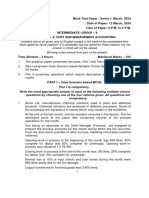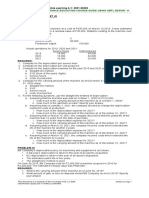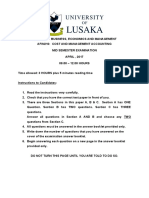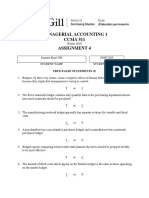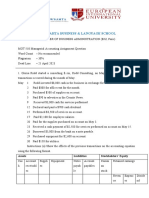HKABE 2014-15 Paper2A Question
HKABE 2014-15 Paper2A Question
Uploaded by
Chan Wai KuenCopyright:
Available Formats
HKABE 2014-15 Paper2A Question
HKABE 2014-15 Paper2A Question
Uploaded by
Chan Wai KuenOriginal Description:
Copyright
Available Formats
Share this document
Did you find this document useful?
Is this content inappropriate?
Copyright:
Available Formats
HKABE 2014-15 Paper2A Question
HKABE 2014-15 Paper2A Question
Uploaded by
Chan Wai KuenCopyright:
Available Formats
HONG KONG ASSOCIATION FOR BUSINESS EDUCATION
HONG KONG DIPLOMA OF SECONDARY EDUCATION
EXAMINATION 2014/15
BUSINESS, ACCOUNTING AND FINANCIAL STUDIES
MOCK EXAMINATION
PAPER 2A
ACCOUNTING MODULE
Time allowed: 2 hours 15 minutes
This paper must be answered in English
INSTRUCTIONS:
1. There are three sections in this paper: Section A (24 marks), Section B (36 marks) and
Section C (20 marks).
2. All questions in Section A and B are compulsory. You are required to answer one of the two
questions in Section C.
3. Show all your workings.
© Hong Kong Association for Business Education
Paper 2A – Accounting Module BAFS Mock Examination 2014/15
SECTION A
Answer ALL questions in this section.
Question 1
Dr. Frost, an alchemist, has invented a low calorie ice cream product to be launched in the coming
summer. Budgeted costs are as follows:
Spring Summer Autumn Winter
Activity level 500 units 1,000 units 700 units 200 units
Cost items $ $ $ $
Direct materials 600 1,200 840 240
Direct labour 1,000 2,000 1,400 400
Quality assurance 300 300 300 300
Equipment hire 700 1,000 1,000 700
Natural gas 600 1,000 760 360
The new ice cream product could be sold at $12 per unit.
REQUIRED:
(a) Classify each of the cost items listed above according to its cost behavior and the first one has
been done for you. (2 marks)
(i) Direct materials – variable cost
(ii) Direct labour –
(iii) Quality assurance –
(iv) Equipment hire –
(v) Natural gas –
(b) Dr. Frost is worrying about the sales volume in winter and you are asked to advise her the
margin of safety for her final decision. Calculate the margin of safety of the product in
quantity for the winter quarter. (4 marks)
(Total: 6 marks)
© Hong Kong Association for Business Education 1
Paper 2A – Accounting Module BAFS Mock Examination 2014/15
Question 2
Aiden Wong is a trained engineer who started his business selling self-baked cake on 1 October
2013. Along with the growth in sales, he decided to make his own oven to increase the capacity of
daily cake production. Expenses incurred in making the oven were as follows:
Cost items $
Hardware materials 4,500
Electronic components 3,000
License fee for running business electronic machine per annum 1,000
Freight for moving the oven to from workshop to the shop 800
Installation cost 500
Electricity for running the machine 4,000
The oven started producing cake on 1 January 2014. Aiden Wong would like to write off the cost of
the oven over its useful life of ten years and there is an expected scrap value of $400 at the end of
its useful life.
REQUIRED:
(a) Calculate the overall capital expenditure of the oven made and name the revenue
expenditure(s) involved in running the oven. (3 marks)
(b) Prepare the accumulated depreciation for the oven for the year ended 30 September 2014.
(3 marks)
(Total: 6 marks)
Question 3
Lut Lut Company runs two departments including the machining department to produce wire used
in the finishing department which wraps the wire with padded fabric to form clothes hangers. The
total costs for producing 100,000 clothes hangers per month are as follows:
Cost items $
Materials 86,400
Wages 44,300
Management salaries 8,500
Carriage outwards 3,900
Rent and Rates 13,500
Depreciation, insurance and maintenance 17,800
A supplier of wire offers to provide the wire needed for the making of clothes hangers at $0.5 each
and as a result, the machining department could be shut down. The facility of the machining
department could then be rented out at $30,000 per month. There would also be a reduction of the
cost of materials by $40,000 and labour cost by $20,000 per month respectively. The management
salaries would, however, be increased by $5,000 per month, to cope with the inspection of buy-in
wire.
REQUIRED:
You are asked to determine whether the company should accept the offer to buy-in wire or to
produce the clothes hanger required per month. (Total: 6 marks)
© Hong Kong Association for Business Education 2
Paper 2A – Accounting Module BAFS Mock Examination 2014/15
Question 4
On 31 March 2014, the bank statement of Zoe showed a debit balance of $34,554 and the cash book
showed a credit balance of $32,222 on its account at the bank. In reconciling the bank statement
with the book balance, the following items were discovered:
(i) The bank had wrongly debited Zoe’s account with a bank charge of $988, which should
have been debited to another client.
(ii) A cheque from debtors had been recorded twice in the cash book.
(iii) Cheques issued amounting to $8,445 had not been presented to the bank for payment.
(iv) The credit side of cash book had been overcast by $1,200.
(v) Lodgments totaling $2,391 for March were not credited by the bank until 3 April 2014.
(vi) The following items were shown on the bank statement but not in the cash book:
(1) A direct deposit of $3,211 by a customer.
(2) Interest income on debenture of $1,500.
(3) Dishonoured cheques from Johnny Limited in the amount of $555.
REQUIRED:
(a) Show the necessary adjustment to be made in the cash book on 31 March 2014.
(3.5 marks)
(b) Prepare a bank reconciliation statement as at 31 March 2014, commencing with the bank
statement balance. (2.5 marks)
(Total: 6 marks)
© Hong Kong Association for Business Education 3
Paper 2A – Accounting Module BAFS Mock Examination 2014/15
SECTION B
Answer ALL questions in this section.
Question 5
Tobias inherited from his deceased uncle forty boxes of wine valued at $10,000 on 1 January 2013.
Having sought a reliable supply of further stock, he opened a small wine selling counter at a large
shopping mall in a busy area of the city.
To start the business, Tobias drew $20,000 from his own bank account to finance the business. As
he is not quite financially well equipped, he runs the business with very strict rules. Some of his
rules are listed below:
(i) Gross profit margin is fixed at 75% and Net Profit to Sales is maintained at 30%.
(ii) The inventory turnover rate is maintained at 8 times a year.
(iii) Average collection period and average payment period are set at 1 month and 3 months
respectively.
(iv) Current ratio is always kept at 2 to 1 in order to build up a good liquidity position.
(v) Closing inventory at 31 December 2013 was $8,000.
The set rules were followed throughout the year with no exception and Tobias is expecting a yearly
financial report which shows the financial performance of the company in the year ended
31 December 2013.
REQUIRED:
(a) Prepare the income statement for the year ended 31 December 2013. (5 marks)
(b) Prepare the statement of financial position as at 31 December 2013. (5 marks)
(Total: 10 marks)
© Hong Kong Association for Business Education 4
Paper 2A – Accounting Module BAFS Mock Examination 2014/15
Question 6
The following information is available for a firm producing and selling a single product:
Budgeted costs (at normal level activity of 240,000 unit) $
Direct material and labour 264,000
Variable production overhead 48,000
Fixed production overhead 144,000
Variable selling and administration overhead 24,000
Fixed selling and administration overhead 96,000
576,000
The overhead absorption rates are based upon normal level activity per period. During the period
just ended, 260,000 units of product were produced and 230,000 units were sold at $3 per unit. At
the beginning of the period 40,000 units were in stock. They were valued at the budgeted costs as
shown above. Actual costs incurred were as per budget.
REQUIRED:
(a) Prepare the absorption costing and marginal costing statement for the period. (8 marks)
(b) Reconcile the profit figure between absorption costing and marginal costing. (2 marks)
(c) State the situation in which the profit figures calculated under both absorption costing and
marginal costing would be the same. (2 marks)
(Total: 12 marks)
© Hong Kong Association for Business Education 5
Paper 2A – Accounting Module BAFS Mock Examination 2014/15
Question 7
On 30 September 2014, the following trial balance was extracted from books of Line Walker Ltd:
Dr Cr
$ $
240,000 ordinary shares of $0.5 each 120,000
General reserve 40,000
Retained profits 16,000
6% preference shares of $1 each 60,000
Share premium 58,000
Equipment at net book value, 1 October 2013 (cost $95,000) 48,750
Inventory as at 1 October 2013 82,772
Accounts receivable 394,380
Accounts payable 42,700
Bank overdraft 13,328
Sales 432,116
Purchases 112,400
Carriage inwards 8,600
Operating expenses 125,392
Interim ordinary dividend 8,050
Interim preference dividend 1,800
782,144 782,144
Additional information:
(i) On 30 September 2014, the inventory had a cost of $52,310 and a net realizable value of
$51,120.
(ii) Some equipment, which acquired on 1 October 2011, costing $10,000 was sold for $5,000
at 1 October 2013. The company had recorded the disposal as cash sales.
(iii) Depreciation of equipment was to be provided at 10% on net book value.
(iv) On 20 September 2014, 100,000 ordinary shares were issued at $2.5 per share.
Applications had been received for 120,000 shares. Excess applications were refunded to
unsuccessful applicants on 4 October 2014. No entries had been made for the above issue.
(v) The board of directors proposed a transfer of $20,000 to the general reserve.
(vi) A final ordinary share dividend of $0.1 per share was proposed. The new shares were not
entitled to the final dividend proposed for the year.
REQUIRED:
(a) Prepare the journal entries to record the issue of ordinary shares. (2 marks)
(b) Prepare an income statement for the year ended 30 September 2014 and a statement of financial
position as at 30 September 2014. (12 marks)
(Total: 14 marks)
© Hong Kong Association for Business Education 6
Paper 2A – Accounting Module BAFS Mock Examination 2014/15
SECTION C
Answer ONE question in this section.
Question 8
Winston and Nancy were in partnership, sharing profit and loss in the ratio 1:1. Interest was
charged on drawings at 5% per annum, and interest was credit on capital at 6% per annum. On
31 December 2012, the trial balance of the partnership was as follows:
$ $
Premise 100,000
Machinery 140,000
Goodwill 10,000
Inventory as at 31 December 2012 80,000
Trades receivable 15,000
Trades payable 28,000
Bank overdraft 17,000
Capital ~ Winston 200,000
Capital ~ Nancy 100,000
345,000 345,000
The partners had realized that their capital account balances do not reflect the following matters:
(i) Interest had not been charged on the following drawings:
Date of drawings Winston Nancy
$ $
1 June 2012 10,080
1 December 2012 15,360
(ii) Interest on partner’s capital at 6% per annum has not been credited.
REQUIRED:
(a) Prepare the capital accounts in column form, showing in detail all the necessary adjustments,
and the revised balances as at 31 December 2012. (4 marks)
On 1 January 2013, they had a new partner, Chris, and the following adjustments were made:
(i) Chris introduced a capital of $70,000 comprising an inventory of $20,000, machinery of
$15,000 and the balance in cash was paid into the partnership bank account on his admission
date.
(ii) Assets were revalued as follows: Premise $230,000; Machinery $180,000 and inventory
$75,000.
© Hong Kong Association for Business Education 7
Paper 2A – Accounting Module BAFS Mock Examination 2014/15
(iii) Goodwill was valued at $90,000. No goodwill account was to remain in the books.
(iv) Winston, Nancy and Chris were to share profits and losses in the ratio of 2:2:1.
(v) No interest on drawings or interest on capital is allowed for the new partnership.
REQUIRED:
(b) Prepare the capital accounts of Winston, Nancy and Chris in columnar form to record the
admission of Chris. (5 marks)
During the year ended 31 December 2013, the partnership made a net loss of $150,000 before
appropriations. The following balances were extracted from books as at 31 December 2013:
$
Premise 200,000
Machinery 165,000
Inventory 60,000
Trades receivable 40,000
Trades payable 50,000
Bank overdraft 40,000
On 31 December 2013, Chris declared bankrupt and the partnership was dissolved as follows:
(i) The premise was sold for $110,000. Inventory was sold for $35,000.
(ii) Nancy took over the machinery at $100,000 and paid the realization expense of $3,400 on the
behalf of the partnership.
(iii) All debtors settled their accounts and a bad debt of $7,600 was recorded.
(iv) The creditors were settled by cash and 10% discount was received.
(v) The deficiency in Chris’s account was to be shared by Winston and Nancy in their profit and
loss sharing ratio.
REQUIRED:
Prepare:
(c) Realization account; and (6 marks)
(d) The capital account of Winston, Nancy and Chris in columnar form for the year ended
31 December 2013 including the final distribution to partners upon dissolution.
(5 marks)
(Total: 20 marks)
© Hong Kong Association for Business Education 8
Paper 2A – Accounting Module BAFS Mock Examination 2014/15
Question 9
Jenny Lau is a Taiwanese who started her business selling snacks of various sorts from Taiwan.
She imports food items from different parts of Taiwan and distributes to food retailers focusing on
healthy diet. Business grows steadily and Jenny is considering further expansion.
News from Taiwan state that many food products were found contaminated with gutter oil, causing
Jenny to fear that loyal customers looking for healthy products might not consume her products.
Jenny formulated a contingency plan on her own with five major measures to regain customers’
confidence towards their products. Major decisions made are summed up as follows:
1. The company bought a set of testing instrument at $50,000 to conduct random checking so as
to detect product faults before the food items reach customers. The instrument could be used
for 5 years and there would be no scrap value at the end of its useful life. However, as there
would probably be no need for continuous testing after the crisis, Jenny paid the cost of the
instrument from her personal bank account and made no accounting records for this
transaction.
2. A press advertisement was placed on major magazines for healthy products in Hong Kong
telling customers that their products were carefully selected from reliable suppliers and extra
testing procedures were launched to safeguard the interests of customers. The cost of the
advertisement was $50,000 and a quarter of it was unpaid pending for receipt of the last issue
in the year. Jenny considered that the advertisement made would help improve the image of
their products and such effect was long lasting. Jenny proposed to amortize the $50,000 over
5 years.
3. In order to further enhance customers’ confidence towards the products of the business, Jenny
introduced a full refund guarantee scheme this year. Customers would get a full refund by
returning the unpacked products to the head office of the business and it was expected that
10% of sales would be returned for refund. Sales of the year amounted $2,500,000 and
$1,000,000 of which was sold with the full refund guarantee. Jenny recorded no provision for
the refund within the product return period that would expire after the year end date.
4. To improve the operating performance, Jenny persuaded a few retailers to make advance order
for the supply of products in the coming financial year by offering a better trade discount.
Two retailers made an advance order amounted $500,000 by paying a deposit of 10% and
goods were to be delivered early next financial year. Jenny proposed to include the advance
order into the credit sales of the year.
© Hong Kong Association for Business Education 9
Paper 2A – Accounting Module BAFS Mock Examination 2014/15
5. To further improve the profit figure of the year, Jenny decided to use the cost price to value the
closing inventory instead of the rule of the lower of cost and net realizable value used for years.
The cost of the closing inventory ascertained at the end of the year was $25,000 but it could be
sold only at $18,000 after paying a testing fee of $3,000. Jenny proposed to value the closing
inventory at $25,000.
REQUIRED
(a) Advise Jenny the correct journal entries at the end of the financial year to each of the five
measures mentioned above. (12.5 marks)
(b) For each of the case listed above, name one accounting concept and briefly explain the
underlying accounting treatment you have suggested in part (a) above. (7.5 marks)
(Total: 20 marks)
END OF PAPER
© Hong Kong Association for Business Education 10
You might also like
- Jncm2e Ws 3b07b eDocument7 pagesJncm2e Ws 3b07b eChan Wai KuenNo ratings yet
- Cost Compiled Past Papers UpdatedDocument364 pagesCost Compiled Past Papers UpdatedAbubakar PalhNo ratings yet
- 2014.12 2015.01 Q&ABooklet P2 EnglishDocument28 pages2014.12 2015.01 Q&ABooklet P2 EnglishKxlxm KxlxmNo ratings yet
- AFAR 14D Cost Accounting (Job Order, Process Costing, JIT Backflush, Activity Based Costing, Joint and ByProducts, Standard Costing)Document9 pagesAFAR 14D Cost Accounting (Job Order, Process Costing, JIT Backflush, Activity Based Costing, Joint and ByProducts, Standard Costing)Jeepee John100% (1)
- Management Accounting ExercisesDocument82 pagesManagement Accounting ExercisesPetrinaNo ratings yet
- This Paper Carries Six Questions. 2. Answer Any Four Questions. 3. Each Question Carries 25 Marks. 4. Use of Non-Programmable Calculators Only Is AllowedDocument6 pagesThis Paper Carries Six Questions. 2. Answer Any Four Questions. 3. Each Question Carries 25 Marks. 4. Use of Non-Programmable Calculators Only Is AllowedtawandaNo ratings yet
- Cma Past PapersDocument437 pagesCma Past PapersTooba Maqbool100% (1)
- Question - Parallel Quiz - Final Term - Cost Accounting 22 - 23Document6 pagesQuestion - Parallel Quiz - Final Term - Cost Accounting 22 - 23Gistima Putra JavandaNo ratings yet
- Question Paper Unit f014 01 RB Management Accounting Resource BookletDocument8 pagesQuestion Paper Unit f014 01 RB Management Accounting Resource Bookletjt7qdbvqhvNo ratings yet
- Test 3Document9 pagesTest 3mrca95346No ratings yet
- Bmac5203 Aq Sept 2023Document9 pagesBmac5203 Aq Sept 2023MohamedNo ratings yet
- Accounting-Grade-12-Project-2022-Term-3-QP-and-MemoDocument17 pagesAccounting-Grade-12-Project-2022-Term-3-QP-and-Memotumeloramushu0No ratings yet
- (Template) COA221 Exam JD2020Document10 pages(Template) COA221 Exam JD2020Godfrey ChabukaNo ratings yet
- Soal Quiz AML #1Document4 pagesSoal Quiz AML #1sabrina hakimNo ratings yet
- Sem 1, 2009 AnnotatedDocument6 pagesSem 1, 2009 Annotatedmoksiuwai100% (2)
- ACYMAG1 Exercise Set #3 - 2T2223Document6 pagesACYMAG1 Exercise Set #3 - 2T2223kyle turlaNo ratings yet
- CAPE Accounting 2010 U2 P2Document9 pagesCAPE Accounting 2010 U2 P2Cool things fuh schoolNo ratings yet
- CT Maf151Document3 pagesCT Maf1512022459384No ratings yet
- MTP 17 51 Questions 1710158898Document11 pagesMTP 17 51 Questions 1710158898Naveen R HegadeNo ratings yet
- Answer Four Questions. All Questions Carry Equal Marks.: P230/2 3 HoursDocument4 pagesAnswer Four Questions. All Questions Carry Equal Marks.: P230/2 3 HoursAbdirahman QoraneNo ratings yet
- MCQ 1Document5 pagesMCQ 1Aashik cgNo ratings yet
- Budget & Budgetary Control (Modular)Document6 pagesBudget & Budgetary Control (Modular)Roland MorganNo ratings yet
- 2019 7010 3C Cost and Management Accounting PDFDocument6 pages2019 7010 3C Cost and Management Accounting PDFMuabecho FatimatuNo ratings yet
- Allama Iqbal Open University, Islamabad (Department of Commerce)Document4 pagesAllama Iqbal Open University, Islamabad (Department of Commerce)gulzar ahmadNo ratings yet
- CA Inter Costing Q MTP 1 May 2024 Castudynotes ComDocument11 pagesCA Inter Costing Q MTP 1 May 2024 Castudynotes ComGaurav kothariNo ratings yet
- Problem 1: (LO 1, 2, 3, 4, 5), AP Lott Company Uses A Job Order Cost System andDocument4 pagesProblem 1: (LO 1, 2, 3, 4, 5), AP Lott Company Uses A Job Order Cost System andIvan BorresNo ratings yet
- Associate Degree of Accounting: Examination Question BookletDocument11 pagesAssociate Degree of Accounting: Examination Question BookletfernandarvNo ratings yet
- Module 5 - PpsDocument4 pagesModule 5 - PpsMIGUEL JOSHUA VILLANUEVANo ratings yet
- AFIN210 Midterm Exam 2017Document5 pagesAFIN210 Midterm Exam 2017William C ManelaNo ratings yet
- Final Exam Paper 2019-2020 (Foundation UNMM)Document6 pagesFinal Exam Paper 2019-2020 (Foundation UNMM)pgpt8qhb4yNo ratings yet
- Paper 3 COST ACCOUNTING AND FINANCIAL MANAGEMENT Intermediated Old - Mock Test 09 Oct 21Document6 pagesPaper 3 COST ACCOUNTING AND FINANCIAL MANAGEMENT Intermediated Old - Mock Test 09 Oct 21srushtishinde2406No ratings yet
- s6 Enterprenuership p2 Revision Past Papers (Ecolebooks.com)Document4 pagess6 Enterprenuership p2 Revision Past Papers (Ecolebooks.com)digitalg256No ratings yet
- AccountingDocument9 pagesAccountingVaibhav BindrooNo ratings yet
- Issues in Management Accounting Bac 4407Document6 pagesIssues in Management Accounting Bac 4407Rugeyye RashidNo ratings yet
- 30784rtpfinalnov2013 5Document0 pages30784rtpfinalnov2013 5kamlesh1714No ratings yet
- Costin A Level - QuestionsDocument38 pagesCostin A Level - Questionsh8n55nkdvrNo ratings yet
- Set eDocument4 pagesSet eKurt HendiveNo ratings yet
- Budgeting Quiz 2: Multiple Choice Identify The Choice That Best Completes The Statement or Answers The QuestionDocument17 pagesBudgeting Quiz 2: Multiple Choice Identify The Choice That Best Completes The Statement or Answers The Questionaldrin elsisuraNo ratings yet
- Exam2505 2012Document8 pagesExam2505 2012Gemeda GirmaNo ratings yet
- Cost & Management Accounting - Paper 7Document7 pagesCost & Management Accounting - Paper 7Turyamureeba JuliusNo ratings yet
- Acmas 2137 Final SADocument5 pagesAcmas 2137 Final SAkakaoNo ratings yet
- CMA QN November 2017Document7 pagesCMA QN November 2017Goremushandu MungarevaniNo ratings yet
- Akuntansi Biaya - Jurica Lucyanda - AKT103 - AKT2X-akt1a-WDocument3 pagesAkuntansi Biaya - Jurica Lucyanda - AKT103 - AKT2X-akt1a-WEryca EugenyaNo ratings yet
- Assignment 1Document2 pagesAssignment 1ilyas muhammadNo ratings yet
- Cost Management Accounting Full Test 1 Nov 2023 Test Paper 1689158389Document17 pagesCost Management Accounting Full Test 1 Nov 2023 Test Paper 1689158389ahanaghosal2022No ratings yet
- Financial Accounting (D.com-II)Document6 pagesFinancial Accounting (D.com-II)Basit RehmanNo ratings yet
- CA Inter Cost and Management Accounting - Answer Key 1Document34 pagesCA Inter Cost and Management Accounting - Answer Key 1Aishwarya NaiduNo ratings yet
- Assignment 4 CCMA-3Document10 pagesAssignment 4 CCMA-3JaspreetNo ratings yet
- Paper 1 CA Inter CostingDocument8 pagesPaper 1 CA Inter CostingtchargeipatchNo ratings yet
- 2014 December Management Accounting L2Document17 pages2014 December Management Accounting L2Dixie CheeloNo ratings yet
- Financial Accounting-EOM Exam-Fall 2014Document8 pagesFinancial Accounting-EOM Exam-Fall 2014glacsecgroupNo ratings yet
- Management Accounting and Finance: Level Iii Examination - January 2021Document9 pagesManagement Accounting and Finance: Level Iii Examination - January 2021Rajendran KajananthanNo ratings yet
- Test Paper 2 CA Inter CostingDocument8 pagesTest Paper 2 CA Inter CostingtchargeipatchNo ratings yet
- Cost and Management AccountingDocument7 pagesCost and Management AccountingMD TANZIM RAHMANNo ratings yet
- Accounting Assignment QuestionDocument4 pagesAccounting Assignment QuestionHtun Lin AungNo ratings yet
- Maf201 Test 2 Jan 2023 QDocument5 pagesMaf201 Test 2 Jan 2023 Qediza adhaNo ratings yet
- Quizzer 1 - Pas 8 and Cash/accrual, Single EntryDocument10 pagesQuizzer 1 - Pas 8 and Cash/accrual, Single Entryjaleummein100% (1)
- 1731160440cost Detail Test 2 CA InterDocument8 pages1731160440cost Detail Test 2 CA Intersdlakum123No ratings yet
- 2014 Dse Bafs 2aDocument9 pages2014 Dse Bafs 2aRay WongNo ratings yet
- Economic Insights from Input–Output Tables for Asia and the PacificFrom EverandEconomic Insights from Input–Output Tables for Asia and the PacificNo ratings yet
- A Comparative Analysis of Tax Administration in Asia and the Pacific: Fifth EditionFrom EverandA Comparative Analysis of Tax Administration in Asia and the Pacific: Fifth EditionNo ratings yet
- Maths OSM TBPDF (Sample) 4A02 eDocument72 pagesMaths OSM TBPDF (Sample) 4A02 eChan Wai KuenNo ratings yet
- Chp3 Wavemotion (CWS)Document218 pagesChp3 Wavemotion (CWS)Chan Wai KuenNo ratings yet
- Medical IV IonizingDocument29 pagesMedical IV IonizingChan Wai KuenNo ratings yet
- Jncm2e Ws 3b07a eDocument8 pagesJncm2e Ws 3b07a eChan Wai KuenNo ratings yet
- Medical I EyeDocument20 pagesMedical I EyeChan Wai KuenNo ratings yet
- Jncm2e Ws 3b07a Sol eDocument3 pagesJncm2e Ws 3b07a Sol eChan Wai KuenNo ratings yet
- Directed Numbers and The Number LineDocument3 pagesDirected Numbers and The Number LineChan Wai KuenNo ratings yet
- S4 05-06 Maths Paper 1 YearlyDocument13 pagesS4 05-06 Maths Paper 1 YearlyChan Wai KuenNo ratings yet
- Performance Measurement II Differential Analysis: The Key To Decision Making - Part IDocument53 pagesPerformance Measurement II Differential Analysis: The Key To Decision Making - Part IWai Ying LaiNo ratings yet
- AP& p1 - Correction of ErrorsDocument7 pagesAP& p1 - Correction of ErrorsJolina Mancera67% (3)
- PARTNERSHIPDocument8 pagesPARTNERSHIPYathesht JainNo ratings yet
- 20140217170246chapter 7 - InCOME STATEMENT-An IntroductionDocument14 pages20140217170246chapter 7 - InCOME STATEMENT-An IntroductionAlhana AwangNo ratings yet
- Chapter 5 - Financial Study 5%Document16 pagesChapter 5 - Financial Study 5%Louris NuquiNo ratings yet
- 5 Year Financial PlanDocument25 pages5 Year Financial Plananwar kadiNo ratings yet
- Capital Budgeting Decisions: A Primer: BM63002: Corporate FinanceDocument38 pagesCapital Budgeting Decisions: A Primer: BM63002: Corporate FinanceSagaeNo ratings yet
- AIS ProblemsDocument48 pagesAIS ProblemsJoan Recca A. JoserNo ratings yet
- Diagnostic ActivityDocument3 pagesDiagnostic ActivityYang JungwonNo ratings yet
- Balance Sheet: As at June 30,2011Document108 pagesBalance Sheet: As at June 30,2011Asfandyar NazirNo ratings yet
- Poa T - 9Document3 pagesPoa T - 9SHEVENA A/P VIJIANNo ratings yet
- Analysisoffinancialstatementofasianpaintsltd 130904112245Document7 pagesAnalysisoffinancialstatementofasianpaintsltd 130904112245Amit PandeyNo ratings yet
- Fa Pilot Paper AnswerDocument11 pagesFa Pilot Paper Answer刘宝英No ratings yet
- Uma Devi Jan PayslipDocument1 pageUma Devi Jan PayslipThivagaran NagapanNo ratings yet
- Trust Deed FormatDocument8 pagesTrust Deed FormatUmer JunaidiNo ratings yet
- Chap002 PPTDocument25 pagesChap002 PPTUmaid FaisalNo ratings yet
- FinmnDocument5 pagesFinmnprey kunNo ratings yet
- 2ND Online Quiz Level 1 Set B (Answers)Document5 pages2ND Online Quiz Level 1 Set B (Answers)Vincent Larrie Moldez100% (1)
- Multiple Choice: Choose The Best Answer Among The Choices. Write Your Answers in CAPITAL Letters. (2 Points Per Requirement)Document3 pagesMultiple Choice: Choose The Best Answer Among The Choices. Write Your Answers in CAPITAL Letters. (2 Points Per Requirement)Kimmy ShawwyNo ratings yet
- FINE4016 Lecture Slides (Financial Statement Analysis I) 20170321 - Student VersionDocument68 pagesFINE4016 Lecture Slides (Financial Statement Analysis I) 20170321 - Student Versionjack100% (2)
- Tax Problem SolutionDocument5 pagesTax Problem SolutionSyed Ashraful Alam RubelNo ratings yet
- Rules Group 'B'Document25 pagesRules Group 'B'DivyaNo ratings yet
- Responsibility AccountingDocument27 pagesResponsibility AccountingZoya KhanNo ratings yet
- Comprehensive Problem 1-4Document1 pageComprehensive Problem 1-4Michelle Morrison80% (5)
- Chapter 3 Part 2Document26 pagesChapter 3 Part 2kuddinis22No ratings yet
- FTR Bulletin 18 - 05 Relocation Allowances - 0Document3 pagesFTR Bulletin 18 - 05 Relocation Allowances - 0MarkWarner100% (1)
- Airlines Operating CostsDocument27 pagesAirlines Operating Costssol-negroNo ratings yet
- Ricardo Pangan ActivityDocument1 pageRicardo Pangan ActivityDanjie Barrios50% (2)
- Financial Accounting Chapter 1 HomeworkDocument5 pagesFinancial Accounting Chapter 1 Homeworkafmojdevn100% (1)
- 04 Accounting Study NotesDocument4 pages04 Accounting Study NotesJonas ScheckNo ratings yet


















